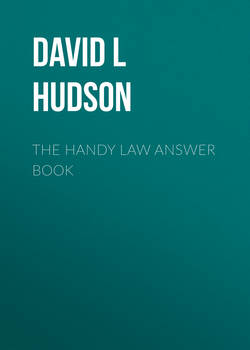Читать книгу The Handy Law Answer Book - David L Hudson - Страница 89
На сайте Литреса книга снята с продажи.
When did Justice Sandra Day O’Connor introduce her endorsement test?
ОглавлениеO’Connor introduced her endorsement test in a concurring opinion in Lynch v. Donnelly (1984). The case involved a Christmas display in Pawtucket, Rhode Island, that featured a nativity scene alongside other more secular symbols, such as a Santa Clause, a reindeer, and as a holiday greeting banner.
LegalSpeak: Van Orden v. Perry (2005)
Chief Justice William Rehnquist (plurality): “In this case we are faced with a display of the Ten Commandments on government property outside the Texas State Capitol. Such acknowledgments of the role played by the Ten Commandments in our Nation’s heritage are common throughout America. We need only look within our own Courtroom. Since 1935, Moses has stood, holding two tablets that reveal portions of the Ten Commandments written in Hebrew, among other lawgivers in the south frieze. Representations of the Ten Commandments adorn the metal gates lining the north and south sides of the Courtroom as well as the doors leading into the Courtroom. Moses also sits on the exterior east facade of the building holding the Ten Commandments tablets.”
Justice Antonin Scalia (concurring): “I would prefer to reach the same result by adopting an Establishment Clause jurisprudence that is in accord with our Nation’s past and present practices, and that can be consistently applied—the central relevant feature of which is that there is nothing unconstitutional in a State’s favoring religion generally, honoring God through public prayer and acknowledgment, or, in a nonproselytizing manner, venerating the Ten Commandments.”
Justice Clarence Thomas (concurring): “There is no question that, based on the original meaning of the Establishment Clause, the Ten Commandments display at issue here is constitutional. In no sense does Texas compel petitioner Van Orden to do anything. The only injury to him is that he takes offense at seeing the monument as he passes it on his way to the Texas Supreme Court Library. He need not stop to read it or even to look at it, let alone to express support for it or adopt the Commandments as guides for his life. The mere presence of the monument along his path involves no coercion and thus does not violate the Establishment Clause.”
Justice Stephen Breyer (concurring): “In certain contexts, a display of the tablets of the Ten Commandments can convey not simply a religious message but also a secular moral message (about proper standards of social conduct). And in certain contexts, a display of the tablets can also convey a historical message (about a historic relation between those standards and the law)—a fact that helps to explain the display of those tablets in dozens of courthouses throughout the Nation, including the Supreme Court of the United States. Here the tablets have been used as part of a display that communicates not simply a religious message, but a secular message as well. The circumstances surrounding the display’s placement on the capitol grounds and its physical setting suggest that the State itself intended the latter, nonreligious aspects of the tablets’ message to predominate. And the monument’s 40-year history on the Texas state grounds indicates that that has been its effect.”
Justice John Paul Stevens (dissenting): “The sole function of the monument on the grounds of Texas’ State Capitol is to display the full text of one version of the Ten Commandments…. Viewed on its face, Texas’ display has no purported connection to God’s role in the formation of Texas or the founding of our Nation; nor does it provide the reasonable observer with any basis to guess that it was erected to honor any individual or organization. The message transmitted by Texas’ chosen display is quite plain: This State endorses the divine code of the “Judeo-Christian” God.”
Justice David Souter (dissenting): “A governmental display of an obviously religious text cannot be squared with neutrality, except in a setting that plausibly indicates that the statement is not placed in view with a predominant purpose on the part of government either to adopt the religious message or to urge its acceptance by others.”
The majority of the court, in an opinion by Chief Justice Warren Burger, applied the Lemon test to find the display permissible. O’Connor proposed what she termed a “clarification” of Lemon by applying an endorsement analysis. Justice O’Connor stated: “The second and more direct infringement is government endorsement or disapproval of religion. Endorsement sends a message to nonadherents that they are outsiders, not full members of the political community, and an accompanying message to adherents that they are insiders, favored members of the political community. Disapproval sends the opposite message.”
